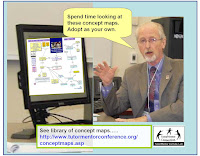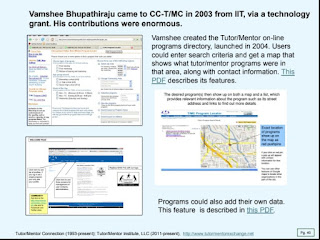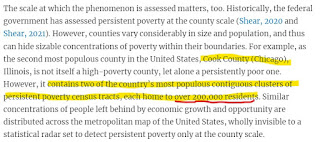My
Twitter feed brought a new report to my attention this week. It's titled "
Persistently poor, left-behind and chronically disconnected" and was written by Kenan Fikri who I've been following for a while. (I'll use Persistent Poverty to refer to this report in the rest of this article.)
The map below was what caught my attention. It shows areas of concentrated poverty in six Ohio cities.
For the past 30 years I've used maps to focus attention on areas of concentrated poverty in Chicago. In this set of MappingforJustice blog articles, I show other cities with the same challenges. In the 1990s a book titled American Apartheid: Segregation and the Making of the Underclass, written by Douglas S. Massey, addressed this same issue.
Below are a few passages from the Persistent Poverty article that I highlighted. (click to enlarge). Go to the report to read this in context.
The abstract shows a focus on social networks and social capital and says "these problems tend not to resolve themselves naturally". The second shows that hidden in affluent Cook County are several clusters of persistent poverty census tracts. Two with over 200,000 residents."
This is not a new problem. This 1994 Chicago Tribune front page pointed to some of the same high poverty areas as are shown in the Persistent Poverty report.
I formed the Tutor/Mentor Connection in Chicago in 1993 (and Tutor/Mentor Institute, LLC in 2011) to try to help volunteer-based tutor, mentor and learning programs grow in these areas as a strategy for expanding the networks of adults from beyond poverty areas who were helping kids through school. I point volunteers and donors to these programs, through lists that I host on this page.
In the Persistent Poverty report, one strategy was to expand networks of support and bridging social capital.
This paragraph highlights the difference between "bonding" social capital which consists of strong ties between family, neighborhoods and/or church groups. These are present in many high poverty communities. What's not present are large doses of "bridging" social capital, which connect youth and families to people and opportunities and solutions beyond the place where they live.
I've been writing about social capital on the Tutor/Mentor blog for many years. Add
these articles to your research.
The graphic below was created in the 1990s to show the design of the tutor/mentor program I led. It's a strategy designed to expand "bridging" social capital for K-12 youth and families in every high poverty area of Chicago and other cities with areas of concentrated poverty.
The hub on this graphic represents a youth, a family, a school or a neighborhood. It shows a volunteer-based tutor/mentor program as a place that draws workplace volunteers from many different backgrounds to serve as one-on-one and group tutors/mentors to youth living in high poverty places of Chicago. The timeline in the middle of the hub emphasizes the 20-plus years it takes to help each youth through school and into jobs where they can earn enough to raise their own kids free from poverty's challenges.
The strategy I've emphasized has been to enlist leaders from every industry to use their own media, visibility and resources to draw volunteers and donors to tutor/mentor programs in all parts of a city, not just to one, or two, high profile programs.
These two PDFs show this goal - Total Quality Mentoring
click hereRole of Leaders -
click here
I've focused on cities because the geographic size makes it difficult for workplace volunteers to meet with kids during the school day, or right after school, because of the distance between work and program locations. The after work and weekend hours are times when that volunteers is more able to stop at a neighborhood program and make an on-going commitment.
However, there are not enough long-term programs and there is inconsistent funding to build and sustain such programs. Here's
one of many articles where I focus on funding.
No solution will come without addressing the flow of dollars to these places!
However, as the map from the Persistent Poverty report shows, the problem of long-term poverty is not limited to cities and urban areas.
These two paragraphs emphasize the different history of places across the US and the lack of simple solutions.
Below is another graphic from my collection.
It emphasizes the role each person can take to be part of a solution. If you've read this far, that means YOU!
Read the report. Here's
the link again.
Update: I asked if there is an interactive map showing the Persistent Poverty data. There is. Follow the link in this post from Twitter (x): Using the interactive map you can zoom into the Chicago area, or any other place with high concentrations of poverty. Look at it. Create your own map stories.
Then, share it with people in your network, so they read it and begin to think about roles they might take in helping more people become involved in efforts that make mentor-rich programs available in all of the high poverty areas shown on these maps.
3-7-2024 update - Here's another article using the EIG dashboards to understand t his data:
https://cityobservatory.org/a-yawning-chasm-patterns-of-neighborhood-distress-in-us-metros/Then visit
this section of the Tutor/Mentor library and read additional reports about poverty, race and inequality in America, that I've been collecting for more than 20 years.
In last Sunday's
Super Bowl a group spent millions of dollars to purchase ads talking about Jesus. I wish someone were spending the same money talking about the research I've been pointing to and mobilizing people to be volunteers, leaders and donors supporting youth tutor, mentor and learning programs in all high poverty areas of big cities across the country.
And building a similar research library showing the different challenges of rural areas, reservations, and other places where solutions may be different than for big cities. Then, drawing readers and planners to that resource so they develop solutions.
And that they do it consistently for the next two decades.
What do you think? Connect with me on social media. (see
links here)
Help me pay the bills. Make a contribution to Fund the Tutor/Mentor Institute, LLC.
click here













































